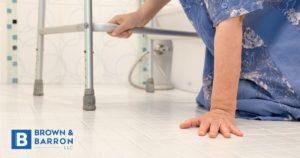Most people recognize that falls are a serious matter for the elderly, but few among us understand just how likely we are to die from a fall once we reach advanced age. As we get older, we are simultaneously more likely to fall and our bodies are more susceptible to serious injury when we do fall. There are roughly 36 million falls reported among the elderly each year, and if you add the estimated number of falls that go unreported, the total number is probably double that. Every year 32,000 older people will lose their lives due to a fall.
When we are younger and healthier, we have a much better chance of avoiding falls, avoiding injury during a fall, and making a speedy recovery from any injuries sustained in a fall. The elderly, on the other hand, face life-threatening consequences from the same type of falls, especially due to brain injuries or hip fractures. Every year, 300,000 elderly people are hospitalized with hip fractures, 95% of which are due to falls. According to the CDC, most traumatic brain injuries among the elderly are due to falls.
The reasons that falling and serious or fatal injuries due to falls occur more often among the elderly are fairly obvious. Poor vision, vitamin deficiencies, mobility issues, medication side effects, loss of balance, diminished mental acuity or dementia, and other factors make us more likely to fall as we get older. A lack of muscle, bone density, and the reflexes necessary to break our falls, contribute to making those falls more serious. Finally, our ability to heal and recover declines as we age, transforming a seemingly mild fall into a long-term injury or death.
How common are falls and fall-related injuries among the elderly?
Here are some other stats regarding the danger and frequency of falls to the elderly, compiled by the Centers for Disease Prevention and Control (CDC).
- One out of five falls causes a serious injury such as broken bones or a head injury
- Each year, 3 million older people are treated in emergency departments for fall injuries.
- Over 800,000 patients a year are hospitalized because of a fall injury, most often because of a head injury or hip fracture
- Each year at least 300,000 older people are hospitalized for hip fractures.
- More than 95% of hip fractures are caused by falling, usually by falling sideways.
- Falls are the most common cause of traumatic brain injuries (TBI).
- In 2015, the total medical costs for falls totaled more than $50 billion. Medicare and Medicaid shouldered 75% of these costs.
Falls at nursing homes
According to the Journal of the American Geriatric Society, about 1,800 people living in nursing homes die each year from falls. The true number is probably larger, because many falls among the elderly go unreported or result in non-fatal injuries, such as permanent mobility issues, brain injuries, depression, or other health problems, and these often trigger steep decline in health and eventual death. The CDC estimates that preventable environmental hazards in nursing homes cause as much as 27% of falls among residents. These hazards include “wet floors, poor lighting, incorrect bed height, and improperly fitted or maintained wheelchairs.” Medication and poor supervision are also factors. A well run nursing home will perform an assessment of the resident to identify the fall risk, create a plan for reducing that risk, and execute that plan with extreme discipline. Unfortunately, most nursing homes do not employ enough staff to possibly meet the needs of residents who are a fall risk. This has been shown by experts to be a matter of corporate greed, and not a human resources issue.
For a list of ways that nursing homes can prevent falls, click here.
Did Your Loved One Fall in Their Nursing Home? We’re Here to Help
Although the measures that nursing homes should take to prevent falls are apparent, many facilities are slow to implement the necessary precautions. If your loved one keeps falling down in their nursing home and you feel they are unsafe there, our Baltimore nursing home abuse and neglect attorneys can help you identify liable parties and hold them accountable for their negligence.
Contact Brown & Barron, LLC at (410) 698-1717 to schedule a free consultation.


